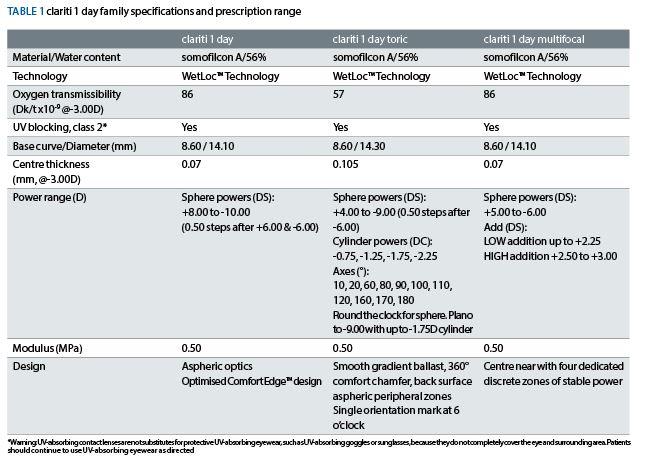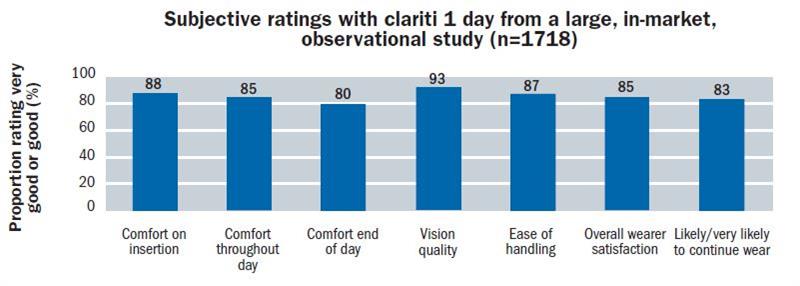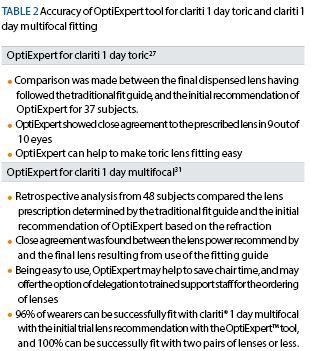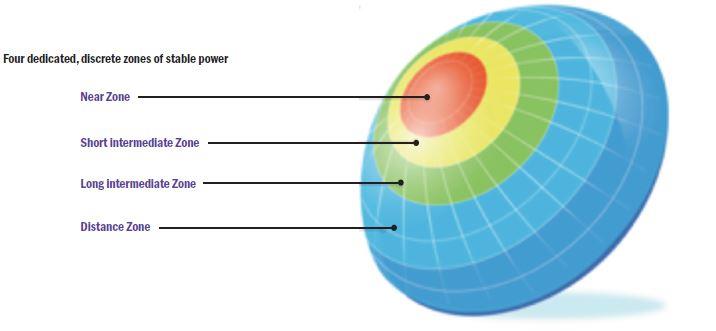
It is clear from evidence stretching back more than 20 years that the ability of silicone hydrogel (SiHy) materials to deliver oxygen to the cornea has largely eliminated hypoxic contact lens (CL) complications.1-4 Replacing lenses every day reduces or removes many of the risk factors associated with reuse of CLs, resulting in the lowest incidence of corneal infiltrative events compared to other soft lens replacement schedules.5-7 The combination of these material and modality attributes have been available, in the form of daily disposable (DD) SiHys, for more than ten years. Their use continues to grow, with the most recent International Contact Lens Prescribing report finding SiHy materials represent an overall average of 63% of soft lens DD fits from the countries involved in the survey.8
Recent insight gathered from eye care professionals (ECPs) in the United States, United Kingdom and Japan finds ECP attitudes to DD SiHys reflects their growth in use.9 ECPs perceive DD SiHys offer long-term eye health and comfort for patients, with 90% agreeing that ‘SiHy is the healthiest material for my DD patients.’9 Naturally, this does not mean DD SiHys are suitable for, or fit to, all patients, with additional cost compared to other DD and reusable options being cited as one of the most common reasons that they are not recommended more frequently.10 However, the patient perspective should not be overlooked, with more than two-thirds of contact lens wearers having an expectation that their ECP will recommend a CL that provides 100% of the available oxygen their eye needs, regardless of cost.11
Clariti 1 day was launched by Sauflon in 2009 and was designed to be an affordable DD SiHy, with a higher water content and a lower modulus, to help enhance comfort and fitting, compared to first generation SiHy CLs. This article reviews the evolution of the Clariti 1 day family and reports on more recent clinical performance versus contemporary lenses. Advice and tips applicable for practice are also shared.
Evolution of Clariti 1 Day
Away from the world of contact lenses it is commonly understood that technology evolves and changes over time. Updated design and improved quality of the final product are regularly seen with our everyday digital devices for example. Contact lenses are no different – in the case of Clariti 1 day, improvement has occurred in both the design of the lens itself and in manufacturing processes.
The acquisition of Sauflon by CooperVision in 2014 enabled further investment in the development of Clariti 1 day. Since that date, CooperVision has invested more than £160 million in manufacturing improvements in the Clariti 1 day family. This illustrates the commitment CooperVision has towards driving the highest standards of design and manufacture to deliver reliable, high quality products.
Advanced moulding techniques deliver micron accuracy and repeatability to create a repeatable optical mould for consistent vision performance in the Clariti 1 day family. In fact, the Clariti 1 day family utilises automated manufacturing and quality checking technologies with the same strict quality management system as Biofinity and all other CooperVision products. This means every single lens from the Clariti 1 day family undergoes inspection twice during the manufacturing process. In addition, a sample from each batch of lenses goes through a further three inspections to check lens parameters, and the moulds for each batch of lenses are also inspected for consistency and accuracy. CooperVision is also committed to sustainable manufacturing. For example, significant investment at our Costa Rica manufacturing facility has resulted in 95% of the site’s electricity coming from renewable sources, 95% of the materials used in the production process being recycled, and 100% of the plastic components used to make the lenses being recycled too.
The Spherical Story
The specifications of Clariti 1 day are detailed in table 1. WetLoc Technology provides exceptional levels of hydration and excellent dehydration resistance, retaining nearly 98% of its water content after six hours of wear.12 While key product features such as the moisture-retaining WetLoc Technology, aspheric optics and UV-blocking* capabilities remain unchanged, an important design update was the launch of the Optimised Comfort Edge. Contact lens edge profile influences a number of factors, including lens mobility, comfort, and interaction with conjunctival tissues.13,14 Significant differences in both subjective and objective responses have been found with the Optimised Comfort Edge compared to the original design. The redesigned edge gives improved comfort on insertion application and reduced conjunctival indentation compared to the original edge.15 This knowledge is useful to bear in mind for any patients who may have tried, and ceased wearing, original Clariti 1 day. That patient may well now be successful in Clariti 1 day with the Optimised Comfort Edge.
 Table 1: Clariti 1 day family specifications and prescription range.
Table 1: Clariti 1 day family specifications and prescription range.
Handling is also crucial in driving successful contact lens wear. One in four new wearers drop out within the first year, with difficulties handling contact lenses being cited as one of the most common reasons.16 When compared with three other DD contact lenses, Clariti 1 day with the Optimised Comfort Edge was shown to have good handling characteristics.17 The same study reported on the overall performance of the lens, finding that Clariti 1 day provides high levels of satisfaction for comfort, dryness, handling and vision quality after one week of daily wear.17
The most relevant indication of product performance is to assess the feedback it receives in the real world. A 2018 observational survey in France did just that for Clariti 1 day sphere, collecting feedback from over 1,700 wearers and 171 ophthalmologists.18 Wearers evaluated their overall satisfaction, comfort, vision and handling at fitting and after around one week of wear. Of those fitted, 63% (n=1,091) were new wearers and 37% existing wearers. Overall fit success rate was high (90%), with no significant difference between new or existing wearers. Overall satisfaction ratings were high, and aside from a small difference between new and habitual wearers for comfort on application, the ratings were not statistically different between groups (figure 1). After one week of wear, more than eight out of 10 (83%) reported they were likely or very likely to continue with Clariti 1 day (85% new wearers vs 78% habitual wearers; p<0.05). Given the positive patient feedback, it was not surprising to find that around nine in 10 ophthalmologists reported good or very good satisfaction with the lenses (89%), and that they would recommend Clariti 1 day to their peers (91%).
 Figure 1: Subjective ratings with clariti 1 day (n=1718)18.
Figure 1: Subjective ratings with clariti 1 day (n=1718)18.
Addressing Astigmatism
Low levels of uncorrected astigmatism have been shown to negatively impact distance and near vision as well as reading speed.20 Three-quarters of a dioptre (0.75DC) is often considered the level of astigmatism at which patients would benefit from being fit with a toric, rather than a spherical, soft contact lens. Recent analysis shows that astigmatism of at least -0.75DC can be found in at least one eye of approximately 50% of patients in a clinic population.21 However, the global average given in the 2019 international contact lens prescribing report shows only 32% of soft lens fits use a toric lens design,8 and while variation in toric lens use exists between countries, overall this average figure illustrates ample opportunity exists to offer the benefits of full astigmatic correction to many more soft contact lens wearers.
Clariti 1 day toric was first launched in 2011, since which time the available power range has been extended up to the current offering (table 1). Further expansion of the Clariti 1 day toric power range is likely in the foreseeable future. Clariti 1 day toric offers a high-precision design so patients can experience excellent optical performance and consistent correction of astigmatism. Back surface aspheric peripheral zones optimise lens stability, and the smooth gradient ballast design minimises interaction between the lens and eyelids to deliver comfort and consistent stability.22
While oxygen delivery is a consideration for all contact lenses, it is of particular interest in soft toric lenses. That is because the amount of oxygen reaching the cornea is dependent on the thickness of the contact lens and soft torics vary in thickness across the lens due to the designs that are incorporated to achieve rotational stability. The increased thickness at certain points on the lens results in significantly different oxygen profile maps between hydrogel and silicone hydrogel materials (figure 2) and is important to bear in mind when fitting toric lenses to patients. Published research has shown the importance of considering peripheral corneal oxygen requirements, with a value of 33Dk/t required to avoid corneal swelling during open eye wear CL wear.24

Figure 2: Oxygen transmissibility map comparison for -3.00/-0.75 x 180 with daily disposable soft toric contact lenses. The Dk/t scale has been standardised to allow like-for-like comparison of Dk/t over the complete lens.23 *Mean Dk/t value across the whole profile.
The same three lenses illustrated in the oxygen profile maps in figure 2 have also been compared for their clinical performance. Two studies evaluated the comfort, vision and clinical performance of clariti 1 day toric, 1-Day Acuvue Moist for Astigmatism and Dailies Toric (All Day Comfort in study one25 and AquaComfort Plus in study two26). Lenses were worn for one week in random order, with 30 subjects completing study one, and 36 completing study two. Similar results were found in both studies, with the conclusion that all three lenses demonstrated a high level of clinical performance, were generally well fitting, maintaining rotational stability, and delivering good levels of comfort and vision. 100% of fits with Clariti 1 day toric were acceptable at both dispensing and the one week follow up, and 100% of the lenses showed rotational stability within 10 degrees at follow up.26 Important for initial patient perception, binocular high contrast visual acuity was better than 6/5 on average (-0.13 ±0.06 logMAR).26
The comparable performance is particularly interesting when the material differences are considered. ECPs may have personal experience of patients reporting reduced comfort when refitted from their habitual hydrogel lens into SiHy. This effect was not evident from these studies, giving confidence to ECPs that when recommending Clariti 1 day toric for its oxygen performance, that it is able to maintain high levels of comfort, comparable to long-established, hydrogel materials.
One of the reasons given by ECPs for not always offering toric lenses to more astigmats is the increased chair time taken to achieve a final fit. With reliable, modern soft designs however, this has been shown to no longer be a concern.27 Beyond improved contact lens design, ECPs are also supported by the emergence of online support tools. CooperVision have developed OptiExpert for just this purpose. The ECP or designated support staff member inputs the spectacle refraction into the app, from which OptiExpert calculates the power of the initial contact lens. This both speeds up the process and supports accurate choice of trial lenses to help maximise successful fitting. Just how accurate the tool can be was recently analysed for both soft toric and multifocal fitting, with the results highlighted in table 2.28
 Table 2: Accuracy of OptiExpert tool for Clariti 1 day toric and Clariti 1 day multifocal fitting.
Table 2: Accuracy of OptiExpert tool for Clariti 1 day toric and Clariti 1 day multifocal fitting.
Performing for Presbyopes
Presbyopia presents considerable opportunity for contact lens fitting. Existing lens wearers need to be counselled on their options, with many preferring the binocular vision advantages of multifocal designs rather than a monovision correction. Once presbyopia manifests, the proportion of patients in a clinic population that require visual correction increases significantly. Many patients within this group may have had no previous need for spectacles, and may wish to have an option other than reading spectacles. Becoming proactive in multifocal contact lens fitting can really help to maintain and grow the overall contact lens business within a practice. Fit data from 2018 reflects this attitude, with just under half (46%) of soft lens fits to presbyopes using a multifocal lens design, and monovision representing just 9% of fits.8 It should be remembered that this group of patients may have different expectations of their contact lenses, with desired wear ranging from full time to regular part-time use, through to occasional wear for specific situations. Use of DDs is an obvious choice for those part-time wearers.
Clariti 1 day multifocal (table 1) is a centre-near design with four dedicated discrete zones of stable power (figure 3). Its unique design provides smooth power transitions across the optical centre to provide excellent vision at all distances. This translates to real-world performance, with nine out of 10 wearers saying that Clariti 1 day multifocal meets their vision needs.29 A recent study refitted 48 habitual multifocal wearers into Clariti 1 day multifocal and measured visual acuity at distance, long- and short-intermediate, and near, as well as capturing subjective feedback. Following two weeks of wear, Clariti 1 day multifocal was found to provide good vision both for acuity measured in a clinical environment as well as with real-world experience.30 Subjective feedback showed more than 80% of subjects agreed that Clariti 1 day multifocal met or exceeded their expectations across all four measured distances, with 98% satisfied with distance vision quality, and 96% satisfied with their near vision.31
 Figure 3: Clariti 1 day multifocal lens design.
Figure 3: Clariti 1 day multifocal lens design.
Fit success rates with multifocal contact lenses can be influenced by a number of factors. Initial patient selection and expectation setting of the likely visual outcomes is important. The next step is to determine the dominant eye, which is often done with a +1.50D blur test. In order to select the most appropriate starting lens to try, the best sphere should be calculated from an up to date refraction. From there, the fitting guide of the lens in question should be followed for initial power selection and the steps taken to enhance vision. Traditionally, the fit guide is a printed reference from the manufacturer, however, OptiExpert provides this service for ECPs for Clariti 1 day multifocal, enabling fast, accurate recommendation of trial lenses based on the spectacle refraction. The results of retrospective analyses are shared in table 2.32 The knowledge that 96% of wearers can be successfully fit with Clariti 1 day multifocal with the initial trial lens recommendation, and 100% successfully fitted with two pairs of lenses or less, with the OptiExpert tool is important.32 This provides confidence to ECPs in the fitting process and product performance, along with being able to effectively plan chair time for multifocal fitting.
Conclusion
Clariti 1 day remains the only DD SiHy available in spherical, toric and multifocal designs. Following £160 million pounds of investment and manufactured to meet CooperVision’s strict levels of quality, the Clariti 1 day family demonstrates consistent, good clinical performance and high levels of wearer satisfaction across the range. When supported by the use of the OptiExpert tool, fit success rates for the toric and multifocal designs are high, helping to minimise the impact on chair time in practice.
The availability of a full family of designs enables lens benefits such as its oxygen delivery and UV-blocking to be offered to a wide selection of patients. The family offering also offers important flexibility in fitting, allowing, for example, the use of a spherical lens in one eye, and a toric in the other for monocular astigmats. So, when patients are considering contact lenses, looking for the benefits of DD SiHys, the affordable option of Clariti 1 day can deliver satisfaction for both the busy practitioner and the patient.
References
- Dumbleton KA, Chalmers RL, Richter DB, et al. Vascular response to extended wear of hydrogel lenses with high and low oxygen permeability. Optometry and vision science 2001;78:147-51.
- Papas EB, Vajdic CM, Austen R, et al. High-oxygen-transmissibility soft contact lenses do not induce limbal hyperaemia. Current eye research 1997;16:942-8.
- Maldonado-Codina C, Morgan PB, Schnider CM, et al. Short-term physiologic response in neophyte subjects fitted with hydrogel and silicone hydrogel contact lenses. Optometry and vision science 2004;81:911-21.
- Stapleton F, Stretton S, Papas E, et al. Silicone hydrogel contact lenses and the ocular surface. The ocular surface 2006;4:24-43.
- Chalmers RL, Wagner H, Mitchell GL, et al. Age and other risk factors for corneal infiltrative and inflammatory events in young soft contact lens wearers from the Contact Lens Assessment in Youth (CLAY) study. Investigative ophthalmology & visual science 2011;52:6690-6.
- Chalmers RL, Keay L, McNally J, et al. Multicenter case-control study of the role of lens materials and care products on the development of corneal infiltrates. Optometry and vision science 2012;89:316-25.
- Chalmers RL, Hickson-Curran SB, Keay L, et al. Rates of adverse events with hydrogel and silicone hydrogel daily disposable lenses in a large postmarket surveillance registry: The TEMPO Registry. Investigative ophthalmology & visual science 2015;56:654-63.
- Morgan P, Woods C, Tranoudis IG, et al. International Contact Lens Prescribing in 2018. Contact Lens Spectrum 2019;34:26-32.
- Orsborn G, Dumbleton K. Eye care professionals’ perceptions of the benefits of daily disposable silicone hydrogel contact lenses. Cont Lens Anterior Eye, 101016/jclae201902012 2019.
- CVI data on file 2017. Barriers to 1-day silicone hydrogel online research. July 2017. Cello Health Insight. Data on file. Survey carried out online in US (n=61), UK (n=47) and Japan (n=50).
- CVI data on file 2018. YouGov online survey on silicone hydrogel lenses. N=1520 adult CL wearers (US 519, UK 501, Japan 500).
- Howarth G, Chatterjee N, Read ML. Assessment of contact lens dehydration using an in vivo and ex vivo methodology. Poster presentation. BCLA conference, Manchester, 2019. In.
- Jones L, Brennan NA, Gonzalez-Meijome J, et al. The TFOS International Workshop on Contact Lens Discomfort: report of the contact lens materials, design, and care subcommittee. Investigative ophthalmology & visual science 2013;54:TFOS37-70.
- Maissa C, Guillon M, Garofalo RJ. Contact lens-induced circumlimbal staining in silicone hydrogel contact lenses worn on a daily wear basis. Eye & contact lens 2012;38:16-26.
- CVI data on file 2015. Non-dispensing, double-masked, randomized, contralateral study in US with c1d; n=20.
- Sulley A, Young G, Hunt C, et al. Retention Rates in New Contact Lens Wearers. Eye & contact lens 2018;44 Suppl 1:S273-S82.
- CVI data on file 2019. Randomised, double-masked, 1-week DD dispensing study with clariti 1 day, single site UK, n=53.
- Webley D, Fournier M. Practitioner and patient experience with a silicone hydrogel, daily disposable contact lens. Optician 2019;April:20-3.
- Woods J, Ng A, Luensmann D, et al. Short-term comfort comparison of a low modulus hydrogel vs a higher modulus silicone hydrogel daily disposable lens. Contact Lens Anterio 2018;41:S42.
- Wolffsohn JS, Bhogal G, Shah S. Effect of uncorrected astigmatism on vision. Journal of cataract and refractive surgery 2011;37:454-60.
- Luensmann D, Schaeffer JL, Rumney NJ, et al. Spectacle prescriptions review to determine prevalence of ametropia and coverage of frequent replacement soft toric contact lenses. Contact lens & anterior eye 2018;41:412-20.
- CVI Data on file 2015 CooperVision lens design
- Patel S, Lumb E. Oxygen transmissibility of various soft daily disposable toric contact lenses using high resolution thickness profiling. Contact Lens and Anterior Eye 2018;41:S62.
- Morgan PB, Brennan NA, Maldonado-Codina C, Quhill W, Rashid K, Efron N. Central and peripheral oxygen transmissibility thresholds to avoid corneal swelling during open eye soft contact lens wear. J Biomed Mater Res B Appl Biomater 2010;92:361-5.
- Cockayne S, Griffiths H. World’s first SiH daily disposable toric lens. Optician 2011:October 16-20.
- CVI data on file 2018. A clinical investigation of three daily disposable soft toric contact lenses. Randomised, single-masked crossover, bilateral controlled study (n=36).
- Sulley A, Young G, Osborn K. A multi-centre study of astigmatic non-users of soft toric contact lenses. BCLA Conference 2011, Poster Presentation.
- Luensmann D, Woods J, Patel S. Validation of an online lens fitting app for two daily disposable toric lenses. Poster presentation. BCLA conference, Manchester, 2019.
- CVI data on file 2018. 92% of study subjects agreed that clariti(R) 1 day multifocal met or exceeded their vision needs. Based on retrospective analysis of 26 patients (52 eyes) with subjective refractions ranging between +5.00D to -6.00D and less than or equal to -1.00D cylinder.
- Woods J, Varikooty J, Jones L. Visual performance with a daily disposable silicone hydrogel center-near progressive design multifocal lens with two independent intermediate zones. Poster presentation. BCLA conference, Manchester, 2019.
- CVI data on file 2019. Prospective, bilateral, subject-masked dispensing study with clariti 1 day multifocal. N=48 habitual soft MFCL wearers at 2 sites in Canada. Subjects with Rx +5.00 to -6.00DS, ≤ -1.00DC and ADDs +1.50 to +2.50D.
- Woods J, Varikooty J, Lumb E. Validation of a multifocal contact lens online fitting app. Poster presentation. BCLA conference, Manchester, 2019. Retrospective analysis refraction data with OptiExpert (n=96 eyes) with Rx range +5.00 to -6.00DS, ≤ -1.00DC; ADDs +1.50 to +2.50D.
